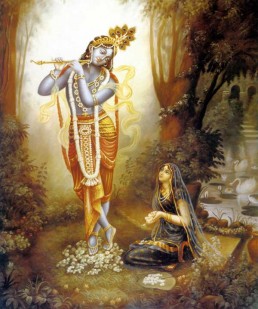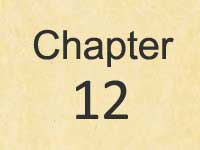
भक्तियोग
Bhakti-yoga - The Yoga of Devotion
The shortest chapter of the Gita but in some ways one of the most important ones because it clearly explains the meaning of a term that is often misunderstood – Bhakti. The Lord succinctly points out the attributes that denote a true Bhakta who is dear to Him, thereby providing us with a list of qualities we must strive to cultivate in ourselves. Below are the main themes of Chapter 12:
Verses 1 - 2
Arjuna’s question and Kṛṣṇa’s answer
Verses 3 - 12
The five stages of bhakti (prasādabuddhi, īśvarārpaṇabuddhi, iṣṭadevatā-upāsanā, virāḍ-upāsanā and akṣara-upāsanā jñā-nayoga)
Verses 13 - 19
Traits of parābhakta (parābaktalakṣaṇa)
Verses 20
Glory of the teaching
Verses 35 - 47
Arjuna’s delusion which stems from his ignorance about the true nature of oneself (moha)
Gita Chapter 12 - 20 Verses
Chapter 12 - 20 Verses
Commentary by Swami Paramarthananda
Background
(The eleventh chapter has paved the way for virāḍ-bhakti. So, in the twelfth chapter, the Lord deals with all aspects of bhakti leading to liberation.)
The chapter begins with Arjuna’s question seeking to know whe-ther virāḍ-bhakta (saguṇabhakta) or akṣara-bhakta (nirguṇa-bhakta) is superior (1).
Lord Kṛṣṇa first answers that saguṇabhakta is superior. (In fact, we cannot compare them. Everyone has to go through both and one can reach the Lord through nirguṇabhakti alone, which the Lord himself points out in the 4th verse. Still the Lord praises saguṇabhakta because of the context.) (2)
From the 3rd verse to the 12th verse, Kṛṣṇa gives out the entire range of bhakti which leads to liberation. In the first 3 verses (3 to 5) Kṛṣṇa talks about nirguṇabhakti which is jñānayoga and which is the direct means for liberation. But, the Lord points out that this would be difficult for unprepared people (5).
From the 6th verse to the 8th verse, the Lord speaks about the next lower stage in the form of virāḍ-upāsanā. He promises that such upāsaka would be rescued from saṃsāra by the Lord. (This does not mean that a virāḍ-upāsaka can get liberation, skipping jñānayoga. The idea is that he becomes fit for jñānayoga and attains liberation through knowledge.)
In the 9th verse, the Lord comes one more step down. If one is incapable of doing virāḍ-upāsana, let him practice meditation on any form of the Lord (iṣṭadevatā-upāsanā). Thus, upāsanā (on virāḍ or iṣṭadevatā) becomes the preparatory step for jñānayoga.
In the next verse (10th), the Lord comes down further. If a person is too extrovert to take up upāsanā, he is asked here to perform his duty (nitya and naimittika) as an offering to the Lord (Īśvarārpaṇam) without expecting any reward.
When a person is full of desires, he is impelled to do desire-born actions (kāmya) expecting results. For such a person Kṛṣṇa prescribes the last step. When he receives the result of kāmya-karmas, let him take it as a prasāda (graceful gift) of the Lord and avoid reaction. Kṛṣṇa indicates this through the word ‘sarvakarmaphalatyāgam’ (11).
The above two steps come under karmayoga. (A karmayogī be-comes fit for upāsanā after some time. Upāsanā makes him qualified for jñānayoga. Jñāna helps him discover his own true ever-free nature.)
Kṛṣṇa concludes this topic by praising the last step of karma-yoga (12).
From the 13th verse up to the 19th verse, Kṛṣṇa gives a clear picture of the characteristics of one who has gone through all these steps and discovered fulfillment. [As a karmayogī and upāsaka he was a devotee of saguṇa-īśvara, seeing the Lord as distinct from him. This is only lower bhakti, because he does not know the true nature of the Lord still (Refer VII-17). His bhakti is saguṇabhakti or bhedabhakti or aparā-bhakti. Once he pursues jñānayoga and discovers his identity with the Lord, his bhakti becomes nirguṇabhakti or abhedabhakti or parā-bhakti, which is an end in itself.] In these verses Kṛṣṇa describes the traits of a parabhakta who is a sthitaprajña (Refer II-55 to 72). (This serves twofold purpose. Firstly, it is an inspiration for a seeker to pursue his sādhanam. Secondly, the natural traits of a parabhakta serve as values for a sādhaka to be deliberately practised.)
This portion can be broadly divided into two. One referring to those virtues which a parabhakta spontaneously enjoys, and the second, referring to those negative traits which he is totally free from.
We can enlist them as follows:
| Sl. | Parabhakta is endowed with: | Parabhakta is free form: | ||
| 1 | Maitrī (Friendliness) | [13] | Dveṣa (Hatred) | [13] |
| 2 | Karuṇā (Compassion) | Mamakāra (‘Mine’-notion) | ||
| [13] | [13] | |||
| 3 | Samatvam (Equanimity) [13] | Ahaṅkāra (‘I’ -notion) | [13] | |
| 4 | Kṣamā (Forberance) | [13] | Udvega (Anxiety) | [15] |
| 5 | Santuṣṭi (Contentment) | [14] | Harṣa (Elation) | [15] |
| 6 | Yatātmatvam (Self-control) | Amarṣa (Envy) | [15] | |
| [14] | ||||
| 7 | Dṛḍhaniścaya (Firm | Self- | Bhayam (Fear) | [15] |
| knowledge) | [14] | |||
| 8 | Bhakti (Devotion) | [14] | Apekṣā (Dependence) | [16] |
| 9 | Gentleness | [15] | Ārambha (Selfish action) [16] | |
| 10 | Śucitvam (Purity) | [16] | Śoka (Grief) | [17] |
| 11 | Dakṣatvam | (Resourceful- | Kāṅkṣā (Desire) | |
| ness) | [16] | [17] | ||
| 12 | Udāsīnatvam (Impartiality) | Pairs of opposites | [17,18,19] | |
| [16] | (comfort and | discomfort, | ||
| honour and dishonour, etc.) | ||||
Kṛṣṇa concludes the teaching by saying — “Those who follow this teaching with faith, keeping Me as the goal, are very dear to Me.” (20)
Thus the main topics in this chapter are:
- Arjuna’s question and Kṛṣṇa’s answer: 1, 2
- The five stages of bhakti (prasādabuddhi, īśvarārpaṇabuddhi, iṣṭadevatā-upāsanā, virāḍ-upāsanā and akṣara-upāsanā jñā-nayoga): 3 to 12
- Traits of parābhakta (parābaktalakṣaṇa): 13 to 19
- Glory of the teaching: 20
Since this chapter talks about all stages of bhakti, this is called ‘Bhaktiyoga’.

